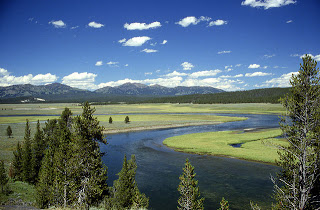A debate among scientists about the geologic formation of the supervolcano encompassing the region around Yellowstone National Park has taken a major step forward, thanks to new evidence provided by a team of international researchers led by University of Rhode Island Professor Christopher Kincaid.In a publication appearing in last week’s edition of Nature Geoscience, the URI team demonstrated that both sides of the debate may be right.
Using a state-of-the-art plate tectonic laboratory model, they showed that volcanism in the Yellowstone area was caused by severely deformed and defunct pieces of a former mantle plume. They further concluded that the plume was affected by circulation currents driven by the movement of tectonic plates at the Cascades subduction zone.
Mantle plumes are hot buoyant upwellings of magma inside Earth. Subduction zones are regions where dense oceanic tectonic plates dive beneath buoyant continental plates. The origins of the Yellowstone supervolcano have been argued for years, with sides disagreeing about the role of mantle plumes.
According to Kincaid, the simple view of mantle plumes is that they have a head and a tail, where the head rises to the surface, producing immense magma structures and the trailing tail interacts with the drifting surface plates to create a chain of smaller volcanoes of progressively younger age. But Yellowstone doesn’t fit this typical mold. Among its oddities, its eastward trail of smaller volcanoes called the Snake River Plain has a mirror-image volcanic chain, the High Lava Plain, that extends to the west. As a result, detractors say the two opposite trails of volcanoes and the curious north-south offset prove the plume model simply cannot work for this area, and that a plates-only model must be at work.
To examine these competing hypotheses, Kincaid, former graduate student Kelsey Druken, and colleagues at the Australian National University built a laboratory model of Earth’s interior using corn syrup to simulate fluid-like motion of Earth’s mantle. The corn syrup has properties that allow researchers to examine complex time changing, three-dimensional motions caused by the collisions of tectonic plates at subduction zones and their effect on unsuspecting buoyant plumes.
By using the model to simulate a mantle plume in the Yellowstone region, the researchers found that it reproduced the characteristically odd patterns in volcanism that are recorded in the rocks of the Pacific Northwest.
“Our model shows that a simple view of mantle plumes is not appropriate when they rise near subduction zones, and that these features get ripped apart in a way that seems to match the patterns in magma output in the northwestern U.S. over the past 20 million years,” said Kincaid, a professor of geological oceanography at the URI Graduate School of Oceanography. “The sinking plate produces a flow field that dominates the interaction with the plume, making the plume passive in many ways and trapping much of the magma producing energy well below the surface. What you see at the surface doesn’t look like what you’d expect from the simple models.”
The next step in Kincaid’s research is to conduct a similar analysis of the geologic formations in the region around the Tonga subduction zone and the Samoan Islands in the South Pacific, another area where some scientists dispute the role of mantle plumes.
According to Kincaid, “A goal of geological oceanography is to understand the relationship between Earth’s convecting interior and our oceans over the entire spectrum of geologic time. This feeds directly into the very pressing need for understanding where Earth’s ocean-climate system is headed, which clearly hinges on our understanding of how it has worked in past.”
Note : The above story is reprinted from materials provided by University of Rhode Island, via EurekAlert!, a service of AAAS.










